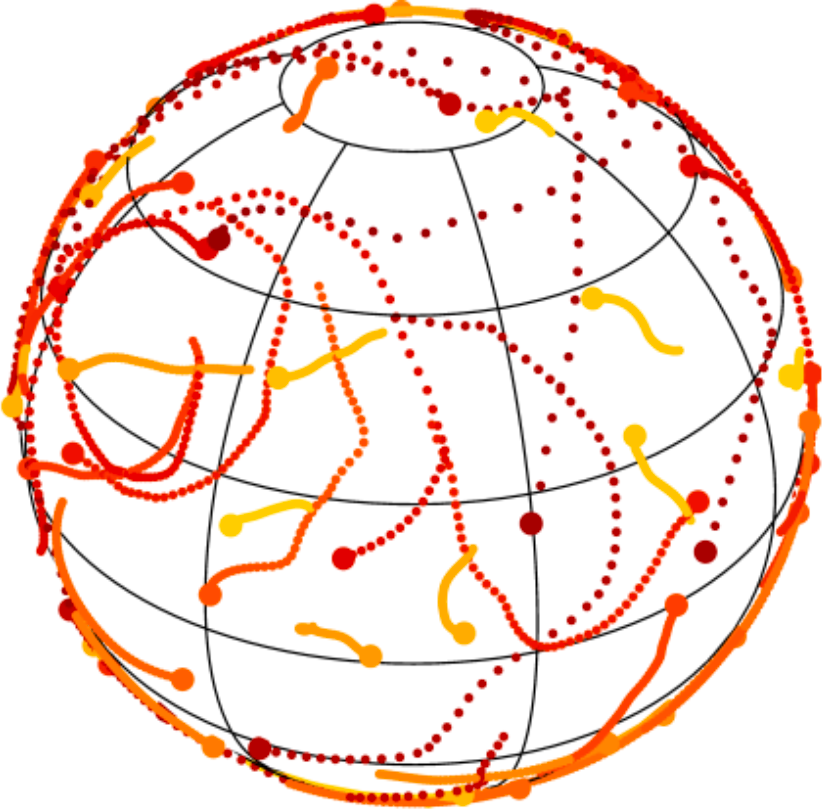Ph D Astronomy2023-Galactic Nuclei
Stellar Dynamics in Galactic Nuclei
Astrophysical Context
Supermassive black holes (BHs) are ubiquitous in external galaxies, while their active feedback plays a critical role in regulating galaxy formation through cosmic age. Yet, the details of their diet and their impact on the stellar cluster orbiting it remains a very much open and challenging question. Indeed, galactic nuclei are fascinating dynamical systems, in particular because the steep potential well generated by the central supermassive BH guarantees the existence of a wide range of dynamical timescales in the system (Alexander2017).
As such, the dynamical evolution of the stellar cluster surrounding the BH comprises numerous evolution processes acting on radically different timescales. These include: (i) the dynamical time, sourced by the fast Keplerian motion around the central BH. Following an orbit-average, amounts then to replacing stars by their underlying Keplerian ellipses; (ii) the precession time (Gravity+2020), during which stars undergo an in-plane precession of their pericentre generated by the cluster's mean potential and the BH's relativistic corrections; (iii) the vector resonant relaxation time (Kocsis+2015), during which stellar orbital orientations undergo stochastic random walks as a result of finite-N perturbations; (iv) the scalar resonant relaxation time (Rauch+1996), during which resonant torques between the precessing ellipses lead to the relaxation of their eccentricities; (v) the non-resonant relaxation time (Bahcall+1976) that sources the relaxation of the ellipses' energies, as driven by local pairwise scatterings among the stars.
Because of its large number of constituents (~1 Million stars within the sphere of influence of SgrA*, the Milky Way's central BH), and the very significant range of timescales ranging from 1yr for the fast dynamical time of the innermost stars up to 10Gyr for the galactic nucleus' overall lifespan, direct numerical explorations of a galactic nucleus' long-term evolution are systematically bound to fail.
Upshot
This is where the heart of the present PhD project lies. Its goal is to tackle the long-term evolution of galactic nuclei using a novel and innovative framework from kinetic theory.
As such, the PhD candidate will develop, tailor, and apply the framework of long-range and long-term kinetic theories in the context of stellar dynamics around a supermassive BH. Once completed, this project will have highlighted the versatility of secular theory to describe dynamics in galactic nuclei, used here to constrain SgrA*'s stellar cluster.
Objectives
- Building upon Giral+2020, the PhD candidate will characterise the efficiency with which stars with similar orientations get slowly separated through potential fluctuations. The PhD candidate will use the recent observations of a clockwise stellar disc in the Milky Ways’ centre to constrain the properties of SgrA*'s old stellar cluster, from this disc's spontaneous dissolution. Can one constrain the distribution of intermediate mass BHs around SgrA*?
- Following Magnan+2022, the PhD candidate will investigate the long-term thermodynamical equilibria of stellar orientations in galactic nuclei. The candidate will rely on maximum entropy approaches to clarify the non-trivial thermodynamical properties of these systems, such as spontaneous symmetry breakings and phase transitions. How likely are spontaneous anisotropic distribution of orientations?
- Galactic nuclei are self-gravitating systems, hence they unavoidably amplify the fluctuations of the gravitational potential present therein. This is the realm of linear response theory. The PhD candidate will tailor the generic method from Fouvry+2022 to the particular case of quasi-Keplerian systems with their degenerate profiles of orbital frequencies. Can one understand the observed lopsided distribution of stars around supermassive BHs as the result of a linear instability?
- Because of their gigantic range of timescales, numerical simulations of galactic nuclei are very challenging, and require appropriate and tailored orbital averages. Following upon Fouvry+2022, the PhD candidate will design an efficient multipole method to directly track the evolution of stellar orientations during the process of vector resonant relaxation. How can such approaches leverage further parallelisation and multiple timesteps?
Requirement
Strong interest in theoretical astronomy, dynamics, analytical and numerical work.
Framework
PhD supervised by Jean-Baptiste Fouvry at the Institut d'Astrophysique de Paris






